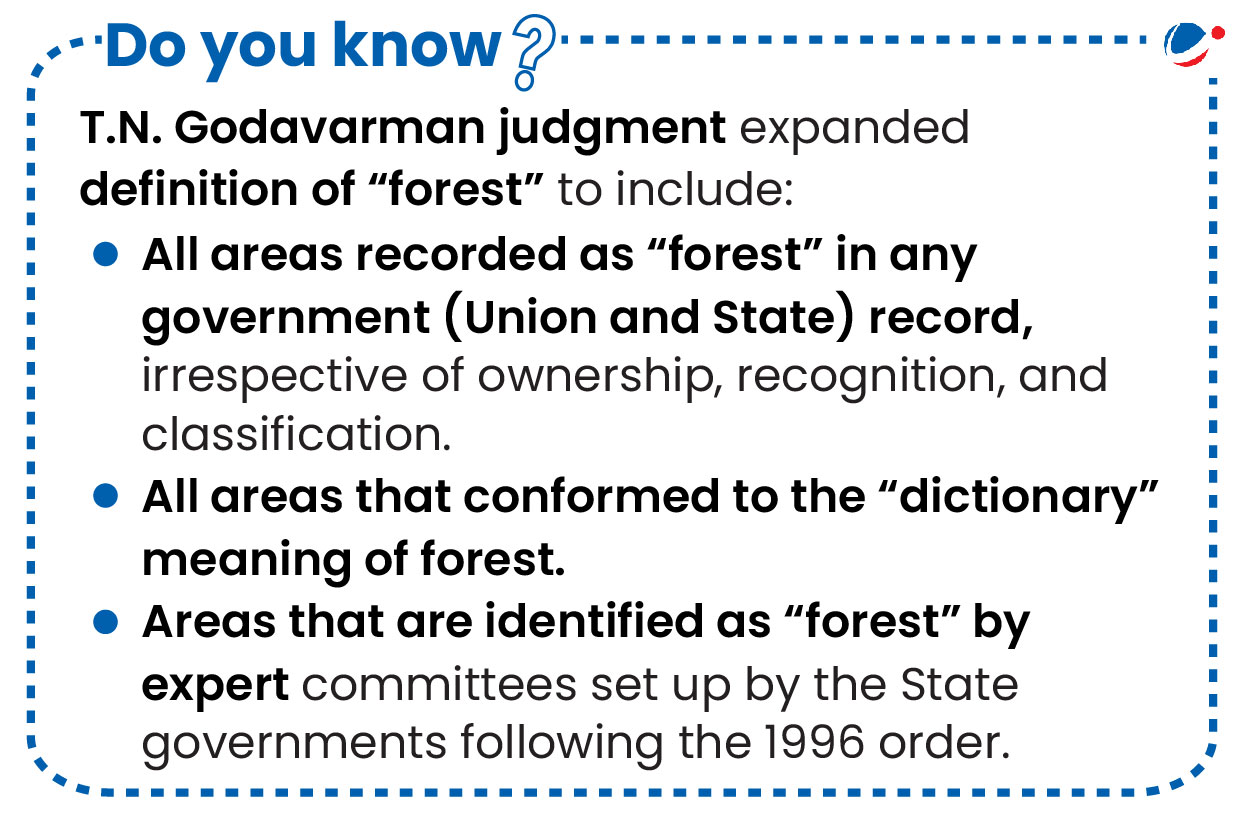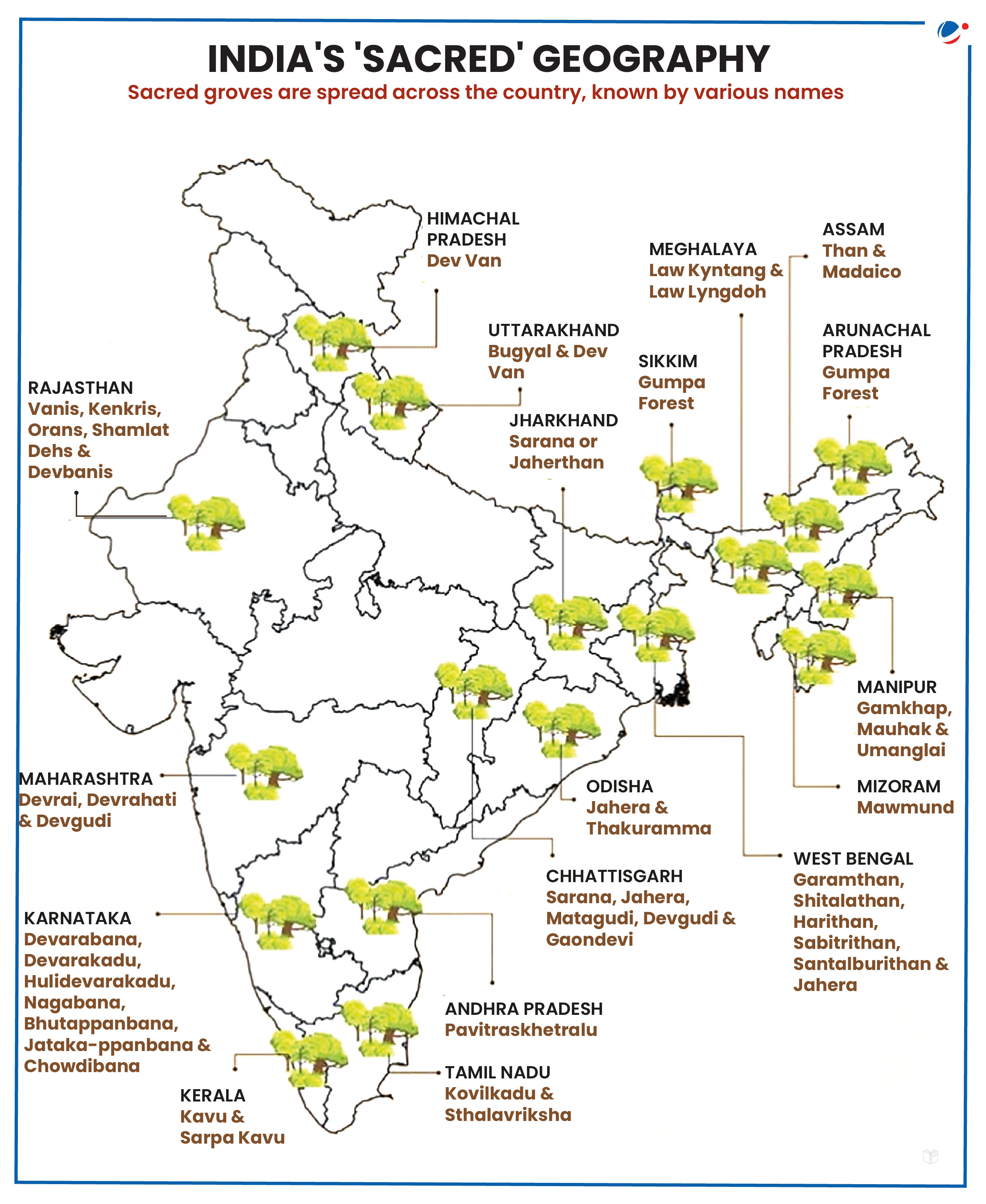Why in the news?
SC pronounced direction on an application for identification of sacred groves such as Orans by the Rajasthan Government in accordance with the T.N. Godavarman judgment (1996).

About Sacred Groves
- Sacred groves comprise of patches of forests or natural vegetation that hold deep religious and spiritual meaning to indigenous communities.
- These spaces are protected by local communities because of their religious beliefs and traditional rituals.
- India is estimated to have around 100,000 to 150,000 sacred groves (IUCN).
- Living Root Bridges (Jingkieng Jri) of Meghalaya a sacred groove is part of the tentative list of UNESCO World Heritage Site.

Key Directives/Suggestions of the Supreme Court
- Legal protection to Sacred Groves: Grant protection to Sacred Groves under the Wildlife Protection Act, 1972, especially through Section 36I (declaration of community reserves).
- Comprehensive policy: The MoEFCC shall create a comprehensive policy for the governance and management of sacred groves across the country.
- Survey: The Ministry shall also develop a plan for nation-wide survey of sacred groves, identifying the area, and extent of the groves.
- Community Participation: The MoEFCC should create policies and programmes that protect the rights of the communities and involve them in sacred groves and forest conservation.
- The court has also suggested the Rajasthan government to empower traditional communities as custodians of sacred groves under the Scheduled Tribes And Other Traditional Forest Dwellers (Recognition Of Forest Rights) Act, 2006.
- Promotion of Piplantari model: Governments must take proactive measures to promote sustainable development and gender equality through the implementation of ideas like the Piplantri model in other regions.
- Piplantri is a village in the Rajsamand district of Rajasthan, which went on to gain international recognition for its unique model where the villagers plant 111 trees whenever a girl child is born.
Why Sacred Groves need protection?
- Cultural: Sacred groves are deeply rooted in cultural traditions, often associated with deities who are believed to protect the community and the groves. These groves also serve as venues for festivals, weddings, and youth socialization.
- E.g. Sabarimala in Kerala and Hariyali in Garhwal.
- Conservation of Biodiversity: They often serve as the last refuge for endemic species in the region.
- E.g. At least 50 rare and endangered plant species of Meghalaya are confined to sacred groves.
- Soil conservation: The vegetation cover of the sacred groves enhances the soil stability and also prevents soil erosion in the area.
- Highland groves (eg. Western Ghats and Himalayan region) are important for their soil conservation.
- Economic and Medicinal benefits: The sacred groves help indigenous communities by providing edible fruits, leaves, fibers, gums, resins and medicinal plants. Thus sacred groves act as a nursery and storehouse of many of the ayurvedic and traditional medicines.
- Growth of livestock-based economies: About 41% livestock in Barmer district of Rajasthan is dependent on the sacred groves "Orans".
Threats and challenges
- Disappearance of the traditional belief systems: Traditional belief systems, which were fundamental to sacred groves, have disappeared, and their rituals are now considered superstition.
- Development activities: Rapid urbanization and developmental interventions, including roads, railways, dams, and commercial forestry, have led to the destruction of sacred groves in many parts of the country.
- E.g. Development projects such as the Ambi Valley Township project in the Western Ghats, destroyed acres of community owned land.
- Due to encroachment, dry deciduous and light loving species invade the area, thus changing the floral composition as well as microclimate.
- Livestock: Overgrazing and trampling by livestock leads to soil erosion. Grazing animals can also outcompete native herbivores for food resources, further threatening local fauna.
- In Punjab, sacred forests are shrinking due to over-grazing and agriculture expansion.
- Invasive species: Invasion by exotic weeds such is a serious threat to endemic species of the groves.
- Eupatorium odoratum, Lantana camara and Prosopis juliflora have caused menace to native biodiversity.
Way Forward
Alongwith the SC's latest guidelines, the following steps can be taken:
- Monitoring: Monitoring of the sacred groves through 'Bio-diversity monitoring committees'.
- Security: Ensuring security through fencing and by establishing "buffer zones" around the sacred groves.
- Community Participation: Village communities should be educated and guided to preserve the grove's sanctity, and the grove conservation programs can include the provision for small incentives for young people.
- Restoration of sacred groves: Restoration activities including planting native species, protection for seedlings and saplings, nursery establishment for rare, endemic plants, measures for soil and water conservation etc. can be undertaken.



